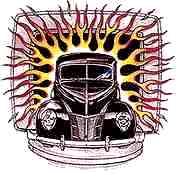

The home of Australian Hot Rodding on the Net
Glass vs SteelSo long as some guy walks around with a magnet in his pocket, there will always be discussion about what a "real" hot rod is made out of. The problem with reproduction parts in general is that sometimes the parts don't fit. Parts between different suppliers may not fit or may require some modification. Also be aware if your buying a reproduction body there may a considerable (6 months) wait depending upon the popularity of the body style and the manufacturer. Secrets of Steel1Depending upon the quality and condition of the body you buy as to how much you will have to invest in repairs and corrections. It also comes down to supply and demand and the fact remains they only ever made so many steel bodies an once their gone their gone. That is unless you can afford one of the new repro steel bodies by Brookville. Steel bodies that years ago were considered basket cases and beyond repair, not even suitable for those hot rodders are now being scooped up, as there are patch panels for almost every conceivable area that now make these bodies repairable. 2A steel car will almost definitely cost you more. There is the initial purchase price and depending upon the body type and desirability as to how much this may inflate the price. Then there is the cost of the replacement panels and welding them in. Then the body preparation to accept todays modern paint systems. Fiberglass Facts1 Not all fiberglass bodies are created equal as there are basically 2 different methods of laying the glass. These are hand laid as either mat or strands or by chopper gun. Most of the bodies manufactured in Australia use the chopper gun, this is a custom unit which draws strands of fiberglass to a hand held head unit, similar to a paint spay gun, as the operator pulls the trigger, compressed air forces the strands out and the gun cuts them to a pre-determined length, the strands are then sprayed with resin from another nozzle in the head unit, the compressed air forcing the strands onto the mould. So the effect is similar to spray painting where you can build up the thickness of the fiberglass by re-coating an area. 2Heat is the biggest problem with fiberglass. Fiberglass cures with heat and is usually the explanation for fiberglass parts that don't fit, as they are often mishandled during shipping and change shape after the leave the factory. 3There are basically 2 methods for structurally reinforcing the fiberglass bodies, wood and steel. Whilst wood is used in some American bodies and those manufactures have good reason for using it, most of the bodies made in Australia and New Zealand feature steel frames. Some of the advantages of wood is that it expands and contracts with heat similar to fiberglass and that it is easier to screw or bolt things to. |
|
Last Updated: 11/08/2002. Copyright © 1996-2004 by
HIGH PERFORMANCE WEB SITES, all rights reserved. All other trademarks, tradenames and/or service marks are the property of their respective holders. Copyright © 1996-2004 Hot-Rod Internet All Rights Reserved. Please read our Disclaimer , Terms and Conditions and Privacy policy |